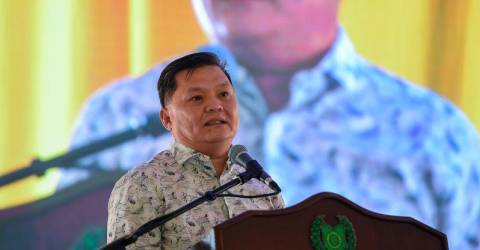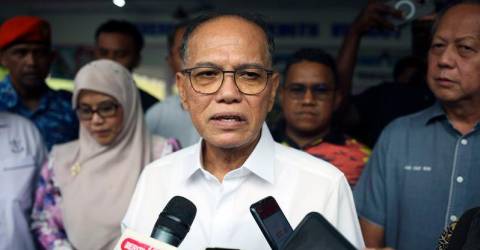ADVERTISE HERE
SERIES 2
In a heartwarming story of passion and perseverance, local musician Victoria Jimy began her journey into traditional music at the age of 38.
Driven by a deep interest and curiosity, she embraced the art form later in life, finding joy in the rhythms and melodies that define her cultural heritage.
Falling in love with preserving and passing on the cultural heritage that connects her ancestors and the history of the Iban community inspired Victoria to play musical instruments and channel her passion.
Now 42, Victoria is a Compliance Officer at Sarawak Digital Economy Corporation Berhad (SDEC) from Kampung Langgir Sri Aman.
Drawing inspiration from rich cultural heritage of Iban community
Victoria draws her inspiration from the rich cultural heritage of the Iban community. Her passion for learning traditional Iban musical instruments stems from a desire to connect with her ancestors and preserve a vital part of her heritage.
“I want to pass down this cultural legacy,” she explains, emphasising the importance of linking the past with the present.
Traditional Iban music plays a crucial role in festivals, ceremonies, and social gatherings, fostering a sense of belonging and unity within the community.
She highlights that learning these instruments not only enhances her musical skills but also strengthens community ties.
The spiritual significance of Iban musical instruments cannot be overlooked. They are integral to rituals and ceremonies, offering a deeper connection to the spiritual practices that are at risk of fading away. “These instruments inspire a connection to our cultural spirituality,” she notes, advocating for their preservation.
Additionally, the artistic expression found in Iban music provides a unique outlet for creativity. She expresses her admiration for the beauty of the sounds produced by these instruments, which encourages her to explore her artistic side further.
In Iban culture, playing these instruments transcends entertainment. They are vital to community identity, symbolising various aspects of life and spirituality. Instruments like the Bebendai, Engkerumong, Kedebong, and Tawak create a harmonious sound that enriches festivals and ceremonies, helping to bring people together in celebration.
As she passionately states, “These sounds are essential to our community spirit.”
Through her efforts, she is not only preserving traditional Iban music but also ensuring that the cultural fabric of her community remains vibrant for generations to come.
Traditional Iban Music at Key Ceremonies
Traditional Iban musical instruments play an essential role in various significant ceremonies and events, reflecting the rich cultural heritage of the Iban community.
One of the most important occasions is the Gawai Dayak Festival, which marks the end of the harvest season. This festival is a time for thanksgiving, renewal, and celebration, with traditional music accompanying the ngajat dance預 ceremonial warrior dance celebrating the harvest.
Another pivotal event is the Miring Ceremony, a ritual offering made to spirits, deities, and ancestors. This ceremony is performed to seek blessings, protection, or success during major life events and is often held before long journeys. The rhythmic sounds of traditional instruments create an atmosphere of reverence, facilitating a respectful exchange between the living and the spiritual world.
Gawai Antu, or the Festival for the Dead, is a rare and elaborate occasion honouring deceased ancestors. Occurring only once in a generation, this festival bids farewell to the spirits of the departed. Traditional music accompanies the chants and dances throughout the ceremony, guiding the spirits to the afterlife and offering comfort and closure to the living.
Weddings, known as Ngambi Indu, are also significant milestones in Iban society. During these celebrations, instruments such as the tawak and bebendai are played in varying rhythms to ensure that bad omens are kept at bay. The music produced is believed to protect the couple during their journey to the wedding ceremony.
Lastly, the Ngajat dance, performed to honour warriors during important festivals like Gawai Dayak, relies on the energetic beats of the tawak, engkeromong, and drums. These sounds not only energise the dancers but also symbolise bravery and victory, encapsulating the essence of Iban cultural pride.
Through these ceremonies, traditional Iban music continues to foster community spirit and cultural identity, ensuring that the rich heritage of the Iban people endures for future generations.
Journey to Mastering Traditional Iban Instruments
Victoria shares her inspiring journey in learning traditional Iban musical instruments. Her passion for the art began in 2019 at the Akademi SADIA (ASADIA), where she was taught by the talented John Nuga. Starting with the betaboh, she learned the Ayun Lundai style, rooted in the regions of Batang Rajang and Batang Ai.
Driven by her enthusiasm, she expanded her repertoire to include other forms of taboh, such as Taboh Kuntau, used for self-defense, and Taboh Ngambi Indu, traditionally played at weddings. She also received instruction in Gendang Rayah from Ragai Lang and Gendang Pampat from Philip Ami.
She emphasises the importance of observation in her learning process, noting that much of the knowledge is passed down through oral tradition. With no written documentation available, mastering these instruments requires a keen ear and the ability to memorise intricate rhythms.
While playing the instruments themselves may seem straightforward, achieving harmony among them demands dedication and patience. Victoria’s commitment to her craft highlights the enduring significance of traditional Iban music in preserving cultural heritage.
The Future of Traditional Iban Music: Techniques and Generational Challenges
In the realm of Iban music, specific techniques and styles play a crucial role in mastering traditional instruments. Beginners typically start by learning to play each instrument individually. As their skills develop, they are gradually introduced to the art of combining musical elements. A key aspect of performance is aligning with the occasion and following the dancer’s cues, ensuring that the music complements the choreography seamlessly.
Despite the growing influence of modern music, which can overshadow traditional Iban sounds, there is a glimmer of hope among younger generations. Many youth view traditional music as outdated, making it challenging to spark interest in its preservation. Yet, institutions like ASADIA are witnessing a rise in enrollment, with students eager to learn. Remarkably, the youngest student on record is just eight years old, a testament to the dedication of supportive parents who encourage this cultural pursuit. This new wave of learners highlights a potential revival of interest in traditional Iban music, balancing the demands of modernity with a deep-rooted cultural heritage.
Challenges Facing Traditional Iban Musicians
Players of traditional Iban musical instruments encounter several significant challenges that threaten the preservation and performance of their cultural heritage.
One major issue is the lack of documentation and formal training. Traditional Iban music relies heavily on oral transmission, making it difficult for new players to learn without access to knowledgeable mentors. The decline in skilled teachers exacerbates this problem, as aging elders pass away, leaving gaps in knowledge transfer that hinder mastery of the instruments.
Instrument maintenance poses another challenge. Many traditional instruments, such as the tawak and bebendai, are made from specific materials that can be costly and difficult to source. Maintaining these fragile instruments requires specialised skills, and proper storage solutions are often lacking, making travel for international performances problematic.
Cultural practices are also evolving, with some traditional ceremonies falling out of favor. Musicians must adapt by integrating their instruments into contemporary contexts, which can dilute their original significance. Additionally, the commitment required to master these instruments can be daunting for younger players, who often juggle other responsibilities.
The rising interest in world music brings its own challenges, as traditional Iban instruments may be appropriated without respect for their cultural significance, leading to feelings of misrepresentation among musicians. Furthermore, limited performance opportunities in mainstream venues can hinder recognition and funding for traditional music, making it increasingly difficult for these artists to sustain their craft.
Blending Tradition with Modernity: The Future of Iban Music
In the vibrant world of traditional Iban music, musicians are navigating the delicate balance between preserving their heritage and adapting to contemporary influences. While some artists firmly adhere to traditional styles, others see potential in blending these sounds with modern genres.
Victoria emphasises her commitment to traditional music, noting, “I cherish the traditional way of playing, as it keeps me connected to my heritage.” She expresses admiration for the unique sounds produced by traditional instruments, which evoke a deep sense of cultural pride. However, she also acknowledges the allure of modern music, describing it as catchy and entertaining. This dual appreciation opens the door for collaboration, allowing traditional tunes to merge with contemporary styles, potentially introducing Iban music to a wider audience.
Technology plays a pivotal role in both preserving and transforming traditional Iban music. Historically reliant on oral transmission, Iban musicians now benefit from modern recording technologies that capture performances and preserve them for future generations. Digital archives enable the study and enjoyment of traditional music, ensuring its survival.
Moreover, music notation software facilitates the documentation of traditional melodies, providing younger musicians with the guidance they need to master these instruments. As elders with traditional knowledge age, such resources become invaluable in keeping the music alive.
The rise of online platforms also revolutions learning. Musicians can share tutorials and lessons on websites like YouTube, making traditional Iban music accessible to a global audience. This outreach fosters appreciation for Iban culture beyond local communities.
Digital music platforms like Spotify and Apple Music further enhance this reach, allowing Iban musicians to showcase their work internationally. The blending of traditional sounds with modern genres not only preserves Iban music but also revitalises it for contemporary listeners.
Looking ahead, innovations like virtual and augmented reality could create immersive experiences, such as virtual Gawai Dayak festivals, where participants worldwide can engage with Iban music and dance. Such advancements promise to keep traditional Iban music vibrant and relevant in an ever-evolving cultural landscape.
Embracing Heritage Through Traditional Iban Music
For many Iban musicians, playing traditional instruments is more than just a performance—it’s a profound connection to their heritage and community. Each instrument carries the stories and rituals of Iban ancestors, allowing musicians to engage with the cultural legacy that has been passed down through generations. This act serves as a tribute to their forebears, fostering a deep sense of cultural pride and continuity.
As musicians learn and perform traditional Iban music, they actively participate in preserving their cultural heritage. These oral traditions are crucial for keeping the Iban legacy alive, ensuring that the wisdom and practices of the past are not forgotten.
Moreover, playing traditional music is a powerful expression of pride in Iban identity. Musicians see themselves as ambassadors of their culture, celebrating and promoting Iban heritage both within their communities and beyond.
In an era increasingly influenced by globalisation, traditional music offers a sense of stability and continuity. It reassures musicians that, despite changing lifestyles and modern influences, the essence of Iban identity remains intact. For many, this grounding connection helps them navigate the complexities of contemporary life while honouring their roots.
 Katubong
Katubong Engkerumong
Engkerumong Pelajar-pelajar ASADIA
Pelajar-pelajar ASADIA Thin – bebendai, thick – tawak
Thin – bebendai, thick – tawak
 11 months ago
97
11 months ago
97



 English (US) ·
English (US) ·